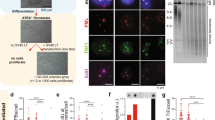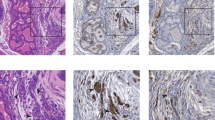Abstract
The INK4A locus encodes two independent but overlapping genes, p16INK4A and p19ARF, and is frequently inactivated in human cancers. The unusual structure of this locus has lead to ambiguity regarding the biological role of each gene. Here we express, in primary mouse embryonic fibroblasts (MEFs), antisense RNA constructs directed specifically towards either p16INK4A or p19ARF. Such constructs induce extended lifespan in primary MEFs; this lifespan extension is reversed upon subsequent elimination of the p16INK4A or p19ARF antisense constructs. In immortal derivatives of cell lines expressing antisense p16INK4A or p19ARF RNA, growth arrest induced by recovery of p16INK4A expression is bypassed by compromising the function of the retinoblastoma protein (Rb), whereas growth arrest induced by re-expression of p19ARF is overcome only by simultaneous inactivation of both the Rb and the p53 pathways. Thus, the physically overlapping p16INK4A and p19ARF genes act in partly overlapping pathways.
This is a preview of subscription content, access via your institution
Access options
Subscribe to this journal
Receive 12 print issues and online access
$209.00 per year
only $17.42 per issue
Buy this article
- Purchase on Springer Link
- Instant access to full article PDF
Prices may be subject to local taxes which are calculated during checkout








Similar content being viewed by others
References
Hayflick, L. & Moorhead, P. S. The serial cultivation of human diploid cell strains. Exp. Cell Res. 25, 585–621 (1961).
Campisi, J. The biology of replicative senescence. Eur. J. Cancer 33, 703–709 (1997).
Bodnar, A. G. et al. Extension of life-span by introduction of telomerase into normal human cells. Science 279, 349– 352 (1998).
Wang, J., Xie, L. Y., Allan, S., Beach, D. & Hannon, G. J. Myc activates telomerase. Genes Dev. 12, 1769–1774 (1998).
Blasco, M. A. et al. Telomere shortening and tumor formation by mouse cells lacking telomerase RNA. Cell 91, 25– 34 (1997).
Kamb, A. Cyclin-dependent kinase inhibitors and human cancer. Curr. Top. Microbiol. Immunol. 227, 139–148 ( 1998).
Ruas, R. & Peters, G. The p16INK4A/CDKN2A tumor suppressor and its relatives. Biochem. Biophys. Acta 1378, 115–177 (1998).
Sherr, C. J. Tumour surveillance via the ARF-p53 pathway. Genes Dev. 12, 2984–2991 (1998).
Kamijo, T. et al. Tumor suppression at the mouse INK4a locus mediated by the alternative reading frame product p19ARF. Cell 91 , 649–659 (1997).
Serrano, M. et al.. Role of the INK4a locus in tumor suppression and cell mortality . Cell 85, 27–37 (1996).
Alcorta, D. A. et al. Involvement of the cyclin-dependent kinase inhibitor p16 (INK4a) in replicative senescence of normal human fibroblasts. Proc. Natl Acad. Sci. USA 93, 13742–13747 (1996).
Zindy, F., Quelle, D. E., Roussel, M. F. & Sherr, C. J. Expression of the p16INK4A tumor suppressor versus other INK4 family members during mouse development and aging. Oncogene 15, 203–211 (1997).
Kiyono, T. et al. Both Rb/p16INK4A inactivation and telomerase activity are required to immortalize human epithelial cells. Nature 396, 84–88 ( 1998)
Noble, J. R. et al. Association of extended in vitro proliferative potential with loss of p16INK4 expression. Oncogene 13, 1259–1268 (1996).
Chin, L., Pomerantz, J. & DePinho, R. A. The INK4a/ARF tumor suppressor: one gene — two products — two pathways. Trends Biochem. Sci. 23, 291–296 (1998).
Hannon, G. J. et al. Genetics in mammalian cells. Science 283, 1129–1130 (1999).
Serrano, M., Gomez-Lahoz, E., DePinho, R. A., Beach, D. & Bar-Sagi, D. Inhibition of ras-induced proliferation and cellular transformation by p16INK4. Science 267, 249–252 ( 1995).
Lukas, J. et al. Retinoblastoma-protein-dependent cell-cycle inhibition by the tumour suppressor p16. Nature 375, 503– 506 (1995)
Medema, R. H., Herrera, R. E., Lam, F. & Weinberg, R. A. Growth suppression by p16ink4 requires functional retinoblastoma protein. Proc. Natl Acad. Sci. USA 92, 6289– 6293 (1995).
Zhang, Y., Xiong, Y. & Yarbrough, W. G. ARF promotes MDM2 degradation and stabilizes p53: ARF-INK4a locus deletion impairs both the Rb and p53 tumor suppression pathways . Cell 92, 725–734 (1998).
Pomerantz, J. et al. The Ink 4a tumor suppressor gene product, p19ARF, interacts with MDM2 and neutralizes MDM2’s inhibition of p53. Cell 92, 713–723 ( 1998).
Kamijo, T. et al. Functional and physical interactions of the ARF tumor suppressor with p53 and Mdm2. Proc. Natl Acad. Sci. USA 95, 8292–8297 (1998).
Xiao, Z. X. et al. Interaction between the retinoblastoma protein and the oncoprotein MDM2. Nature 375, 694–698 (1995).
Sun, P. Q., Dong, P., Dai, K., Hannon, G. J. & Beach, D. H. p53-independent function of MDM2 may contribute to TGFβ resistance in tumors. Science 282, 2270–2272 (1998).
Macleod, K. pRb and E2F-1 in mouse development and tumorigenesis. Curr. Opin. Genet. Dev. 9, 31–39 ( 1999)
Johnson, D. G. & Schneider-Broussard, R. Role of E2F in cell cycle control and cancer. Frontiers Biosci. 3, 447–448 (1998).
Qin, X. Q., Livingston, D. M., Kaelin, W. G. Jr & Adams, P. D. Deregulated transcription factor E2F-1 expression leads to S-phase entry and p53-mediated apoptosis. Proc. Natl Acad. Sci. USA 91 , 10918–10922 (1994).
Hiebert, S. W. et al. E2F-1:DP-1 induces p53 and overrides survival factors to trigger apoptosis. Mol. Cell. Biol. 15, 6864– 6874 (1995)
Pan, H. et al. Key roles for E2F1 in signaling p53-dependent apoptosis and in cell division within developing tumors. Mol. Cell 2, 283–292 (1998).
Nevins, J. R., Leone, G., DeGregori, J. & Jakoi, L. Role of the Rb/E2F pathway in cell growth control. J. Cell Physiol. 173 , 233–236 (1997)
Weinberg, R. A. The retinoblastoma protein and cell cycle control. Cell 81, 323–330 (1995).
Rittling, S. R. & Denhardt, D. T. p53 mutations in spontaneously immortalized 3T12 but not 3T3 mouse embryo cells. Oncogene 7, 935–942 ( 1992)
Iravani, M., Dhat, R. & Price, C. M. Methylation of the multi tumor suppressor gene-2 (MTS2,CDKN1, p15INK4B) in childhood acute lymphoblasticleukemia. Oncogene 15, 2609–2614 ( 1997).
Acknowledgements
We thank H. Brady for providing p53–/– MEFs; A. Badley for MDM2–/– p53–/– MEFs; and M. Serrano and G. Hannon for critical reading of the manuscript. A.C. is a recipient of an EMBO long-term fellowship. J.D.H. is supported by a fellowship from the Leukaemia Research Fund. J.D.H. and A.C. were also supported by the Cancer Research Campaign. D.H.B. is supported by the Hugh and Catherine Stevenson Fund and Cancer Research Campaign.
Correspondence and requests for materials should be addressed to D.H.B.
Author information
Authors and Affiliations
Corresponding author
Rights and permissions
About this article
Cite this article
Carnero, A., Hudson, J., Price, C. et al. p16INK4A and p19ARF act in overlapping pathways in cellular immortalization. Nat Cell Biol 2, 148–155 (2000). https://doi.org/10.1038/35004020
Received:
Revised:
Accepted:
Published:
Issue Date:
DOI: https://doi.org/10.1038/35004020
This article is cited by
-
Immortalized murine tenocyte cells: a novel and innovative tool for tendon research
Scientific Reports (2023)
-
AMPK-dependent activation of the Cyclin Y/CDK16 complex controls autophagy
Nature Communications (2020)
-
Overtraining elevates serum protease level, increases renal p16INK4α gene expression and induces apoptosis in rat kidney
Sport Sciences for Health (2018)
-
Establishment of immortalized mouse intestinal epithelial cells line and study of effects of Arg-Arg on inflammatory response
In Vitro Cellular & Developmental Biology - Animal (2017)
-
LRF maintains genome integrity by regulating the non-homologous end joining pathway of DNA repair
Nature Communications (2015)



